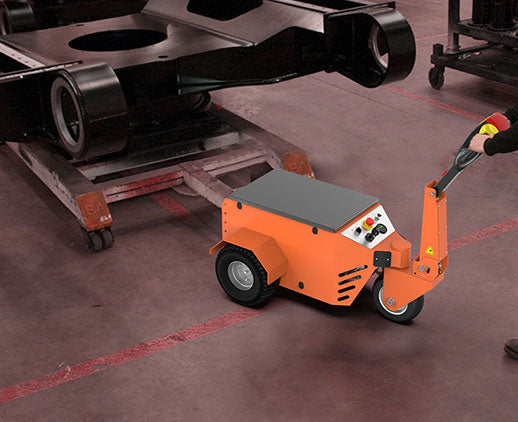What Is Semi Automated Material Handling

Semi-automated material handling refers to the use of Automated Guided Vehicles (AGVs) to partially replace manual labor for improved efficiency. From 2019 to 2023, the market size reached $12.6 billion, with an annual growth rate of around 7%. AGVs, costing about $100,000 each, increase handling efficiency by 30%, though smaller businesses still face high investment challenges.
Status and challenges of semi-automated material handling
In the realm of Material handling, semi-automated material handling technology has already become an indispensable part. Between 2019 and 2023, the market size of semiautomated material handling systems worldwide was estimated at $12.6 billion, with an annual growth rate in a window just under five years projected to be about seven percent.
This growth has been driven by the application of AGV technology, and a number of companies such as Toshiba Tec, Daifuku have already begun to partially replace conventional manual handling in order to improve efficiency. Amazon, as the largest e-commerce platform in the world, has more than 10,000 AGV vehicle robots established in its various distribution centers to increase handling efficiency by more than 30%, reduce labor costs, and minimize material-handling errors.
Nevertheless, overcoming the many challenges of semi-automated systems remains a tall order. Each AGV system comes at an investment of around $100,000, and for smaller businesses looking to deploy multiple units individually, this acts as a deterrent in itself. Most companies want to recover their investment in the short term, so they can only save 2%–5% of costs due to the complexity and long time for initial deployment.
However, it is still irreplaceable in high-intensity work environments due to the advantage of added ergonomics as a semi-automated operation. The AGVs can operate at the speed of 3 meters per hour for 12 hours throughout, which is far more than a human worker's work cycle. This demonstrates how this technology would significantly increase working efficiency.
As Elon Musk said: "The pace of innovation is never as fast as people expect." Even the semi-automated systems are prone to unstable navigation and high equipment maintenance costs. Still, the long-term benefits are sufficient to pay off short-term troubles for companies determined in their pursuit of a fully upgraded handling process.
Future development direction of AGV technology
Intelligence, Flexibility, and Cost—The Future Extreme of AGV Technology. The AGV market is expected to expand at an annual 9.8% rate for the next five years and grow more than $35 billion in size, Chiang noted.
Key drivers of this growth include the integration of 5G, Internet-of-Things (IoT), and artificial intelligence technologies that allow AGVs to move from traditional preset routes toward more autonomous navigation with real-time decision-making capabilities. Currently, AGVs can already perform precise movement in complex environments with the combination of LIDAR and vision navigation systems.
High-end AGVs boast navigation accuracy at the millimeter level and operating speeds of up to 2.5 meters per second, significantly increasing storage operation efficiency required for high-precision job manufacturing.
While the cost of a single AGV is significant upfront, The International Federation of Robotics (IFR) estimates that by 2030, manufacturing costs for an AGV will have declined by about 20%, reducing it to under $250,000. As a result, a growing number of small and medium-sized enterprises will be able to afford AGVs, promoting the industry in more areas.
Intelligence and cost efficiency will be more important in the next step of AGV technology when AGVs move from manual or semi-automatic equipment to fully automatic handling systems.
How are emerging technologies driving semi-automated material handling
Semi-automated material handling is undergoing a massive transformation due to innovations in several emerging technologies—especially artificial intelligence (AI), the Internet of Things, and 5G.
The 2023 market analysis report shows that AI-driven AGVs achieve up to a 15%-20% higher throughput compared with traditional systems, allowing more items per hour to be processed automatically and reducing human errors.
With AGVs in operation, real-time operating systems adjust according to the warehouse layout, while path-planning algorithms lean toward full AI operation. The method for device-to-device connection has been streamlined using IoT technology. By 2022, Amazon completed a full-scale IoT-based automatic material handling system, which helped save more than $5 million in operating costs.
The communication speed between devices is now much more efficient on 5G, reducing any possibility of latency. Compared to the previous generation, which saved 15% of daily working time, new-generation AGVs benefit significantly from stable 5G connections, especially in high-frequency operations like warehousing and logistics companies.
These advances indicate a shift from traditional manual and semi-automated systems to more intelligent solutions. Technological evolution continues to enhance manufacturers’ efficiency by combining greater speed with lower costs without sacrificing flexibility.
How can enterprises use AGV to improve their competitiveness in the future
In the future, companies will differentiate themselves from their competitors based on efficiency, cost management, and the flexibility of AGV technology.
Companies with AGV systems have improved material handling efficiency by 25%-30%, resulting in shorter production cycles and faster delivery times. The autonomous navigation and path optimization functions demonstrate the high efficiency that can be achieved by AGVs, with navigation error limited to 2 millimeters.
JD, for example, has reduced its overall handling time by 40%, while single-item pick-up efficiency has more than doubled. In multiple warehouses, Geek+ has deployed over 2,000 AGVs, which have optimized warehouse operations to a whole new level, directly improving large-scale productivity.
The average return period for AGVs is approximately 2 to 3 years, although the initial investment in an AGV product line can be substantial. Midea Group’s logistics director has stated that AGVs save more than $3 million in labor costs each year. These savings provide long-term financial strength needed for sustainable earnings growth.
Cainiao Network used AGV technology to process 50% more fully automated orders during the Double 11 shopping festival than normal operations handled. As a popular type of automation, AGV technology has become a new core driver for companies to enhance their competitiveness.














